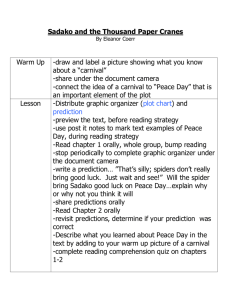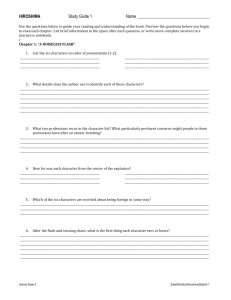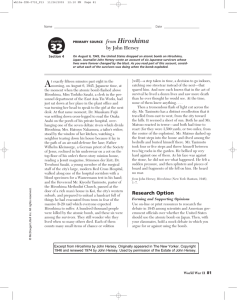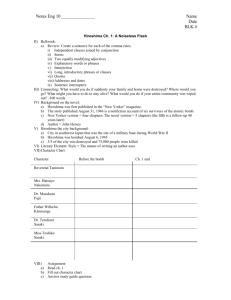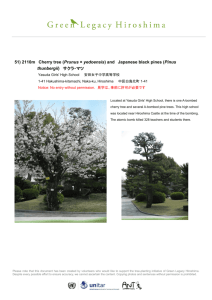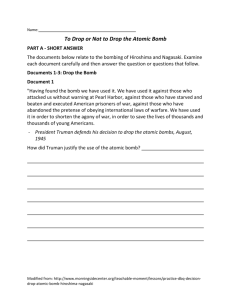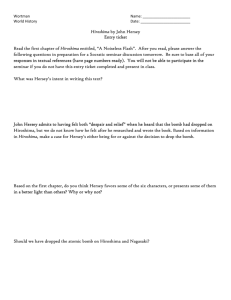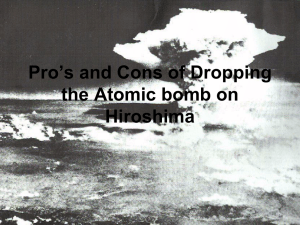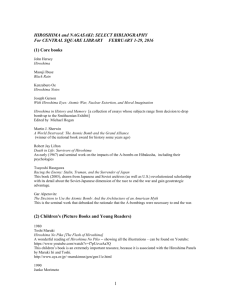Japan Resources by Vincenzo La Ruina
advertisement
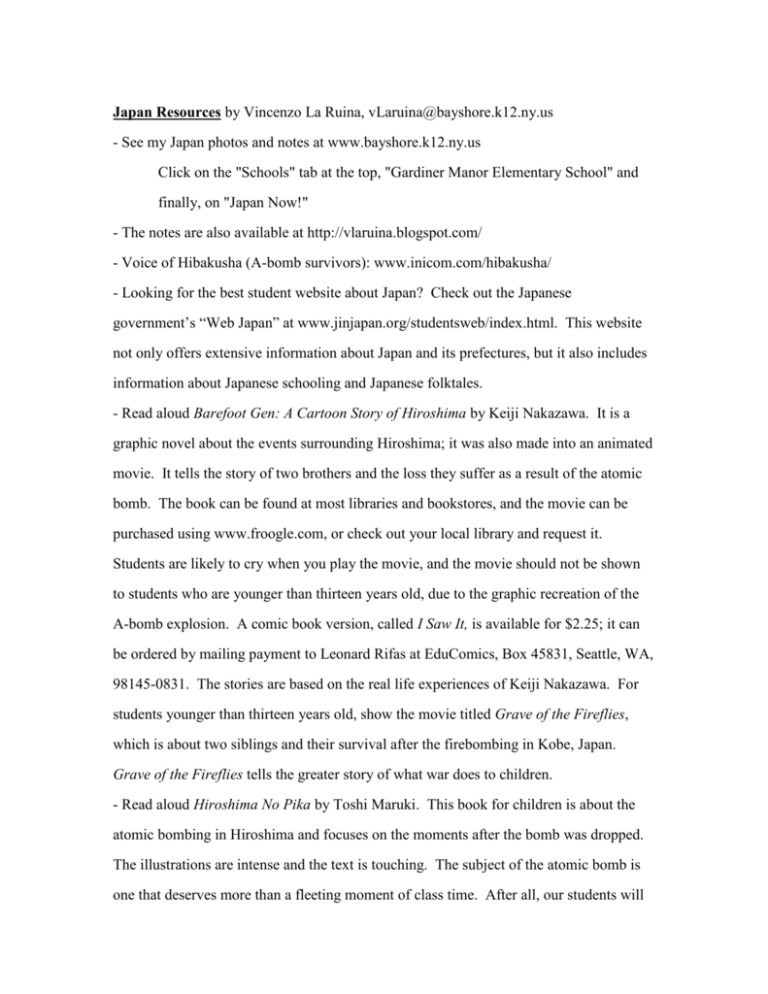
Japan Resources by Vincenzo La Ruina, vLaruina@bayshore.k12.ny.us - See my Japan photos and notes at www.bayshore.k12.ny.us Click on the "Schools" tab at the top, "Gardiner Manor Elementary School" and finally, on "Japan Now!" - The notes are also available at http://vlaruina.blogspot.com/ - Voice of Hibakusha (A-bomb survivors): www.inicom.com/hibakusha/ - Looking for the best student website about Japan? Check out the Japanese government’s “Web Japan” at www.jinjapan.org/studentsweb/index.html. This website not only offers extensive information about Japan and its prefectures, but it also includes information about Japanese schooling and Japanese folktales. - Read aloud Barefoot Gen: A Cartoon Story of Hiroshima by Keiji Nakazawa. It is a graphic novel about the events surrounding Hiroshima; it was also made into an animated movie. It tells the story of two brothers and the loss they suffer as a result of the atomic bomb. The book can be found at most libraries and bookstores, and the movie can be purchased using www.froogle.com, or check out your local library and request it. Students are likely to cry when you play the movie, and the movie should not be shown to students who are younger than thirteen years old, due to the graphic recreation of the A-bomb explosion. A comic book version, called I Saw It, is available for $2.25; it can be ordered by mailing payment to Leonard Rifas at EduComics, Box 45831, Seattle, WA, 98145-0831. The stories are based on the real life experiences of Keiji Nakazawa. For students younger than thirteen years old, show the movie titled Grave of the Fireflies, which is about two siblings and their survival after the firebombing in Kobe, Japan. Grave of the Fireflies tells the greater story of what war does to children. - Read aloud Hiroshima No Pika by Toshi Maruki. This book for children is about the atomic bombing in Hiroshima and focuses on the moments after the bomb was dropped. The illustrations are intense and the text is touching. The subject of the atomic bomb is one that deserves more than a fleeting moment of class time. After all, our students will be the ones making the decision in the future about whether atomic weapons are used again or not; we as teachers should make sure they fully understand the effects of the atomic bomb. -Are you teaching about the atomic bombings in Hiroshima or Nagasaki? Read the actual testimonies of the Hibakusha (A-bomb survivors) at www.inicom/hibakusha/. The testimonies send a powerful message of peace; read them aloud. The words of the actual A-bomb survivors are more powerful than any book about the subject. A book titled Children of the A-Bomb, by Arata Osada, is a series if testimonies by child Hibakusha, aged between ten and eighteen years old. I also recommend Sadako and the Thousand Paper Cranes by Eleanor Coerr, Shin’s Tricycle by Tatsuharo Kodama, and Hiroshima by Laurence Yep; these books are excellent read-aloud books for elementary aged children. -Want to see a Flash animation of Sadako’s story? Check out www.pcf.city.hiroshima.jp, and click on “English” and go to “Students Peace Station.” You’ll find an interesting Flash animation about Sadako’s story, called “Sadako Story 21.” The animation also includes a part about how we can promote world peace. -Check out www.skype.com for a free program that allows you to talk free to anyone using the internet. When I was in Japan, I spoke with my students each day using Skype. I created a free account for the classroom and one for myself, and then I “called” the class each day at a specified time. The sound quality is pretty good; nothing more than a computer with a high-speed internet connection and microphone are needed. -Apply to the Japan Fulbright Memorial Fund Teacher Program. If you are chosen as a participant in the program, you will go to Japan for three weeks and learn about Japan’s excellent educational system and culture. I went November of 2005, and visited Tokyo and Hiroshima. Everything I thought about Japanese schooling was wrong. Check out the program at www.fulbrightmemorialfund.jp. -Need an online translator? Check out Babel Fish Translation at http://babelfish.altavista.com for free translations of text or web pages. The translator is able to translate between the following languages: English, Chinese, Dutch, French, German, Greek, Italian, Japanese, Korean, Portuguese, Russian, Spanish. -Read aloud The Big Book for Peace, compiled by Ann Durell and Marilyn Sachs; it has wonderful stories about peace and is written and illustrated by talented people, including Lloyd Alexander, Jean Fritz, Lois Lowry, Marilyn Sachs, Yoshiko Uchida, and Maurice Sendak. It contains a variety of writing, including fables and poems, and is appropriate for ages 7-12. "To Children Who Don't Know the Atomic Bomb" 8:15 a.m. on August 6, 1945 a very clear morning. The mother preparing her baby's milk, the old man watering his potted plants, the old woman offering flowers at her Buddhist altar, the young boy eating breakfast, the father starting work at his company, the thousands walking to work on the street, all died. Not knowing an atomic bomb would be dropped, they lived as usual. Suddenly, a flash. "Ah!" Just as they saw it, people in houses were shoved over and smashed. People walking on streets were blown away. People were burned-faces,arms,legs-all over. by Akiko Takakura People were killed, all over the city of Hiroshima by a single bomb. Those who died. A hundred? No. A thousand? No. Ten thousand? No, many, many more than that. More people than we can count died, speechless, knowing nothing. Others suffered terrible burns, horrific injuries. Some were thrown so hard their stomachs ripped open, their spines broke. Whole bodies filled with glass shards. Clothes disappeared, burned and tattered. Fires came right after the explosion. Hiroshima engulfed in flames. Everyone fleeing, not knowing where they were or where to go. Everyone barefoot, crying tears of anger and grief, hair sticking up, they ran on broken glass, smashed roofs along a long, wide road of fire. Blood flowed. Burned skin peeled and dangled. Whirlwinds of fire raged here and there. Hundreds, thousands of fire balls 30-centimeters across whirled right at us. It was hard to breath in the flames, hard to see in the smoke. What will become of us? Those who survived, injured and burned, shouted, "Help! Help!" at the top of their lungs. One woman walking on the road died and then her fingers burned, a blue flame shortening them like candles, a gray liquid trickling down her palms and dripping to the ground. Whose fingers were those? More than 50 years later, I remember that blue flame, and my heart nearly bursts with sorrow. From Eyewitness Testimonies: Appeals from the A-bomb Survivors, published by the Hiroshima Peace Culture Foundation
